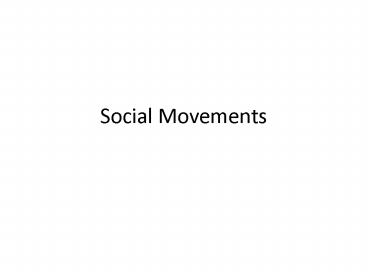Social Movements - PowerPoint PPT Presentation
Title:
Social Movements
Description:
Social Movements Examples Suffrage Movement: mid-1800s to 1920 Civil Rights Movement: 1950s-1960s (alternatively, the long civil rights movement, began in early ... – PowerPoint PPT presentation
Number of Views:482
Avg rating:3.0/5.0
Title: Social Movements
1
Social Movements
2
Examples
- Suffrage Movement mid-1800s to 1920
- Civil Rights Movement 1950s-1960s
(alternatively, the long civil rights movement,
began in early 1920s) - Gay Liberation Movement 1964 in Canada for
creating a positive gay identity and employment
rights - Movement for Global Justice 1999 Battle in
Seattle
3
Definitions
- collective challenges, based on common purposes
and social solidarities, in sustained interaction
with elites, opponents, and authorities
(Straggenborg 2011 5, emphasis in original). - Social movements are one form of contentious
politics, that is, participants are typically
outsiders with regard to the established power
structure (6, emphasis in original).
4
Types of Social MovementsHarper Leicht (2002)
Instrumental Expressive
Reform Permutations of existing social arrangements and culture 1. REFORMATIVE labor movement, NAACP (org), ERA (legislation), tax reform (legislation), antiabortion and abortion rights (legislation and org) 3. ALTERNATIVE Christian evangelicalism, various enthusiasms (Trekkies, joggers)
Radical Significant departure from existing social arrangements 2. TRANSFORMATIVE Bolsheviks, religious fundamentalism (e.g., Christian and Islamic) 4. REDEMPTIVE cults and other isolated environments (e.g., Jim Jones and the Peoples Temple)
5
Social Movement Organizations
- a complex, or formal, organization which
identifies its goals with the preferences of a
social movement or a countermovement opposed to
a social movement and attempts to implement
those goals (Straggenborg, p. 6, quoting
McCarthy and Zald) - United Mine Workers www.umwa.org
- Greenpeace www.greenpeace.org
6
Theories of Social Movements
- 1. Collective Behavior
- 2. Resource Mobilization
- 3. Political Process
- 4. New Social Movement
7
Collective Behavior
- Known as strain or breakdown theories.
- They typically posit that collective behavior
comes about during a period of social disruption,
when grievances are deeply felt, rather than
being a standard part of the political process
(Staggenborg 12-13). - Also known as the classical approach.
8
Resource Mobilization
- Social movements seen as a continuation of the
political process, albeit by disorderly means
(Staggenborg 17). - Social movements emerge when resources are
present such as - --1. moral (e.g., legitimacy)
- --2. cultural (e.g., tactical repertoires and
strategic know-how)
9
Resource Mobilization, contd
- --3. social-organizational (e.g., networks)
- --4. human (e.g., labor and experience of
activists - --5. material (e.g., money and office space)
10
Political Process
- social movements are most likely to emerge when
potential collective actors perceive that
conditions are favorable (Staggenborg 19). - Focus on the existence of favorable structures
of political opportunity (Harper Leicht
144). - May take several forms
- decline in the effectiveness of repression
- effective power of political elites is
undermined by internal fragmentation and
disunity - broadening of access to institutional
participation in the political process
11
Collective Action FramesPart of the approach of
both RM and PO
- Refers to the narrative structure of the
movement. - CAFs are ways of capturing the importance of
meanings and ideas in stimulating protest
(Staggenborg 20, citing Benford and Snow). - For example, We are a movement in support of
local food systems to decrease our reliance on a
fossil-fuel dependent industrial food chain that
destroys the environment.
12
New Social Movement
- Movements seen as reactions to the modernizing
process in advanced industrial capitalist
societies (Harper Leicht 147).
13
- Support for this type of movement activity is
associated with postmaterialist values, which
focus on quality of life and self-expression,
rather than materialist values, which emphasize
economic and physical security (Staggenborg, p.
104 citing Inglehart 1995).
14
- Emphasizes collective identity, which refers to
the sense of shared experiences and values that
connects individuals to movements and gives
participants a sense of collective agency or
feeling that they can effect change through
collective action (Staggenborg 22).
15
Major Theories of Social MovementsStaggenborg
(2011)
THEORETICAL PERSPECTIVE ORIGINS OF MOVEMENTS IMPORTANT FEATURES AND FOCUSES KEY OUTCOMES OF MOVEMENTS
Collective Behavior Social disruptions strains, grievances precipitating events Psychology of protest emergent organization and norms protest outside institutional structures New meanings and forms of organization
Resource Mobilization and Political Process Pre-existing organization resources political opportunities and threats master frames Connections between social movements and political process mobilizing structures framing strategies institutional and non-institutional forms of action New resources, organizations and frames cultural and political changes
New Social Movement Large-scale changes everyday networks and organizational structures new types of grievances Collective identity submerged networks new types of structures, constituents and ideologies New types of values, identities and organizations cultural innovations
16
Environmental MovementOff-shoot Modern Food
Movements
- Environmental modern movement in North America
began largely as a result of the publication of
Rachel Carsons Silent Spring in 1962. - Environmental activists who came out of the
protest movements of the 1960s adopted many of
the direct-action tactics used by the civil
rights, antiwar, and womens movements (e.g.,
protest, boycotts) (Staggenborg 2011 102)
17
Modern Food Movements
- Organic
- Back-to-land
- Slow Food
- Local (defined) www.attra.ncat.org

